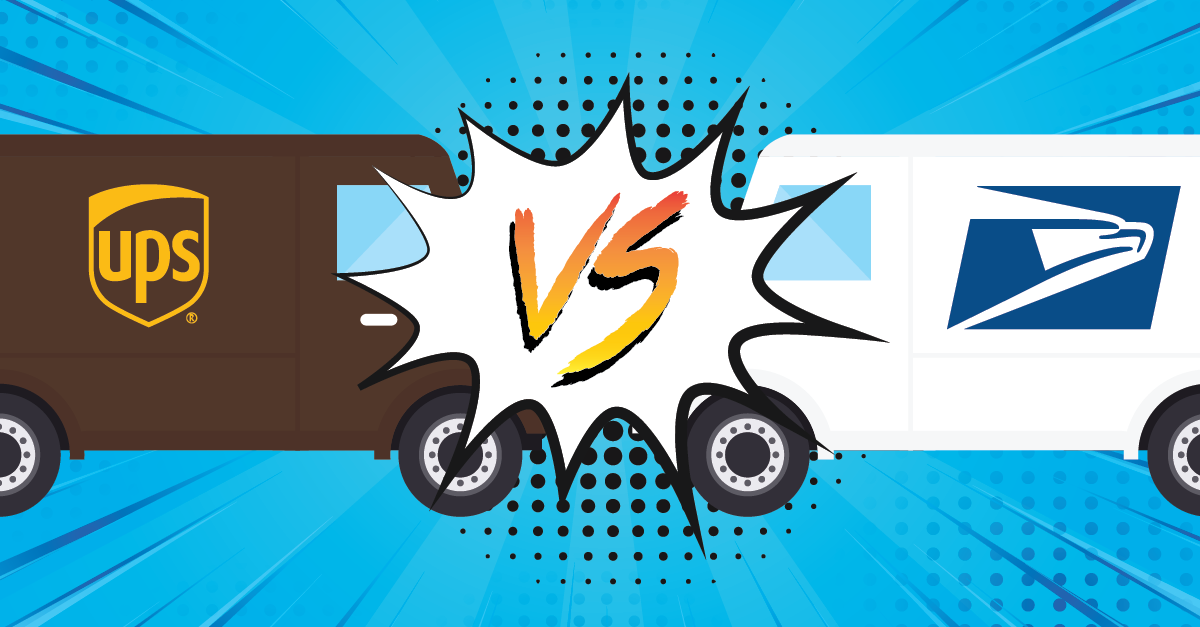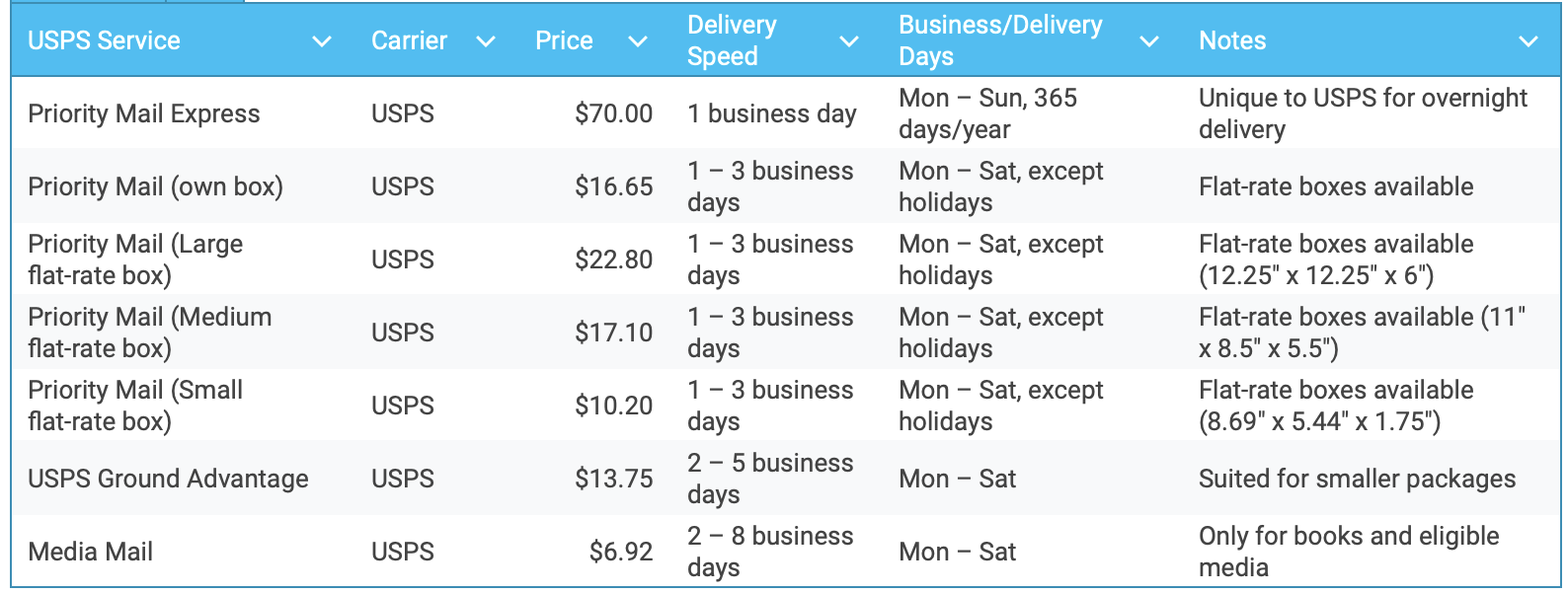
When it comes to comparing parcel shippers, an extra “S” makes a world of difference. UPS (aka United Parcel Service) and the USPS (aka United States Postal Service) have overlapping services, but they’re vastly distinct in structure, mission, and primary consumer audience, especially when it comes to shipping rates and international shipping.
What do these differences mean for your business? The most common points of comparison are UPS vs USPS rates, delivery times, and shipping options. How quickly and cost-effectively you can get your product into the hands of a customer is based on both shipper selection and working with the right logistics partners to achieve shipping optimization, whether you're running an ecommerce business or just need to send a small package.
Overview: UPS vs USPS
First, let’s take a quick look at UPS vs USPS structure and history to understand how these organizations differ.
USPS Overview
The United States Postal Service (USPS), which was established in 1792 as a permanent fixture of the federal government within the United States, has since evolved through a rich history, as documented in its USPS history timeline.
While it exists as an independent agency of the executive branch of the government, it must operate under a business model, competing against current carriers. In 2022, the USPS reported $78.5 billion in revenue and offered various shipping options, such as USPS Priority Mail and USPS First Class Mail.
USPS:
-
- Delivers 23.8 million packages and 421.4 million pieces of mail each business day
- Delivers more packages and mail than any other postal service in the world
- Serves 165+ million addresses nationwide, including PO Box delivery
- Is the only carrier that can deliver to U.S. Post Office boxes
- Can connect with any international postal service to deliver worldwide
- Has a workforce of 635,000+ employees
- Offers shipping rates for USPS Priority, USPS Priority Mail Express, and other services
UPS Overview
United Parcel Service (UPS) was founded in 1907 and is currently headquartered in Atlanta, Georgia. Its functions are split between Global Small Package Operations, with $83.9 billion in revenue in 2022, and Supply Chain Solutions, with revenue of $16.4 billion in 2022. UPS Worldwide Express is part of its diverse shipping carrier services.
UPS:
-
- Delivers 24.3 million packages and documents each day
- Operates in 220+ countries and territories, including international shipping
- Offers UPS SurePost among other shipping options for smaller packages and lightweight packages
- Has a workforce of 500,000+ employees
UPS vs USPS Rates
Understanding the cost differences between UPS and USPS is crucial for making informed shipping decisions. Here’s a detailed comparison of their pricing structures:
- UPS Pricing:
- Ground Shipping: Generally higher than USPS for smaller packages but offers guaranteed transit times and full tracking.
- Air Shipping: Offers next-day and two-day delivery options, typically at a premium. Guaranteed delivery dates/times and full tracking capabilities enhance the customer experience for time-sensitive and/or higher-value shipments.
- International Shipping: Competitive rates for larger shipments but can be costly for smaller packages. Guaranteed delivery dates for most services and countries, along with full tracking visibility.
- USPS Pricing:
- First-Class Mail: Cost-effective for lightweight flats and envelopes.
- USPS Ground Advantage: Competitive pricing for low-weight parcels, typically delivered within 2-5 days, but not guaranteed.
- Priority Mail: Flat rate options are beneficial for heavier items within the same USPS-branded packaging, usually delivering within 1-3 days.
- International Shipping: Affordable rates for small parcels, but limited tracking capabilities.
All of the above services include package coverage up to $100, except First-Class Mail.
As shippers consider their carrier strategies and ideal customer experience, it’s crucial to find the right balance of price and service. Both UPS and USPS offer customized pricing contracts for shippers of all sizes that can help reduce costs.
UPS and USPS Shipping Services Comparison
Note: The prices listed below were calculated for a five-pound package measuring five inches on all sides, shipped from Chicago to New York City. The shipping cost may vary based on factors such as class mail and flat-rate shipping.
Services: USPS
There are four key offerings for parcel shipping via USPS, all of which limit weight to 70 pounds. Pricing varies by delivery speed but also by what you’re shipping and whether it will fit into one of the three flat-rate boxes they provide.

Services: UPS
UPS offers a variety of shipping options but customizes their rates based on volume and shipping characteristics. To determine the actual rate you’ll need to know the service type, weight, and zone. Individual package maximums under the following UPS services are 150 pounds and 108 inches in length.

Choosing the Right Carrier: UPS vs USPS
One of the most common comparisons for businesses is UPS ground vs USPS priority mail services, but you’ll want to take more than the stated delivery window and retail rates into account. Consider, for instance, that while UPS Ground Shipping states a delivery time window of one to five days, 90% of their packages are actually delivered in three days or less.
As experts in logistics with over 100 years of combined experience, including negotiating UPS shipping contracts, we can tell you that:
- USPS tends to be the lower shipping cost within the U.S. for flat-rate or up to 13-pound packages
- UPS wins out for larger package shipping, particularly if complex or international shipping
- Both carriers offer package tracking, but UPS wins out for advanced tracking capabilities
- UPS has more fees but also more opportunities for negotiation and volume discounting
For a more comprehensive comparison, especially if you’re considering other major carriers, you might find our dedicated blogs 'DHL vs UPS' and 'FedEx vs UPS' insightful.
At Lojistic, our parcel auditing services, parcel contract negotiation, and discounted parcel rates help businesses optimize their shipping strategies. By automating carrier invoice management and negotiating your shipping contracts, we ensure you receive the most cost-effective and efficient shipping solutions, whether you're dealing with USPS, UPS, or any other carrier. With our insights, you can make informed decisions that enhance your bottom line and streamline your shipping processes.
Sources:
U.S. Postal Service Corporate Communications. Postal Facts. https://facts.usps.com/
Statistica. United States Postal Service's revenue from 2004 to 2022. https://www.statista.com/statistics/320215/global-revenue-of-the-us-postal-service/
U.S. Postal Service Corporate Communications. One Day in the Postal Service. https://facts.usps.com/one-day/
U.S. Postal Service Corporate Communications. Size and Scope. https://facts.usps.com/size-and-scope/
United Parcel Service of America, Inc. Corporate Facts: UPS. https://about.ups.com/content/dam/upsstories/assets/fact-sheets/ups-global/Corporate-Fact-Sheet-3-15-2023.pdf
United Parcel Service of America, Inc.. Company Facts. https://about.ups.com/us/en/our-company/global-presence/corporate-facts.html
USPS. Retail Postage Price Calculator. https://postcalc.usps.com/Calculator
UPS. Calculate Time and Cost. https://wwwapps.ups.com/ctc/request?loc=en_US
UPS. Domestic Shipping. https://www.ups.com/us/en/support/shipping-support/shipping-services/domestic.page

Author
Bryan Van Suchtelen
Bryan Van Suchtelen
Corporate Director of Parcel Rate Services
Prior to joining Lojistic in 2015, Bryan enjoyed a 26-year career with UPS where his roles included Pricing, Field Sales and Director-level Sales Management of some of UPS’s largest customers.
At Lojistic, Bryan leverages his wealth of experience/expertise to identify and execute supply chain cost management solutions for parcel shippers of all sizes. Bryan has helped his customers reduce their shipping spend by tens of millions of dollars.

